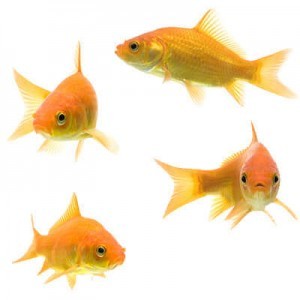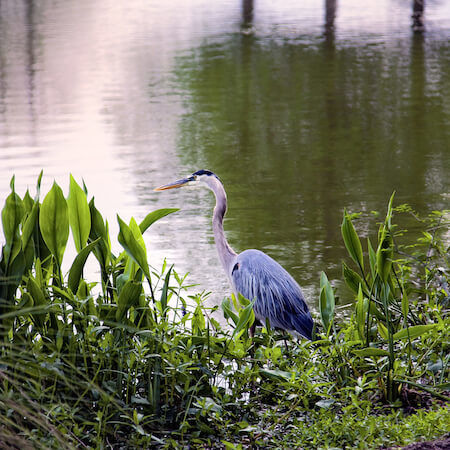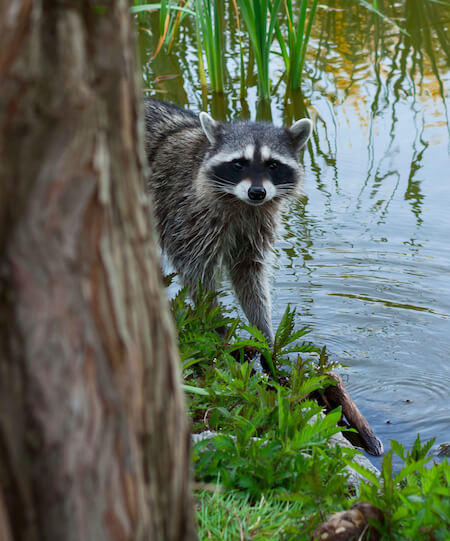Protect a Goldfish Pond from Predators

Goldfish Predators
- Cats
- Dogs
- Raccoons
- Coyotes
- Herons and Egrets
- Birds of Prey
- Some Aquatic Turtles
Shallow water and unprotected pond banks create a great place for goldfish predators. Herons and egrets can wade in the shallow waters and pick off curious goldfish that swim too close. Four legged animals can get right up on the goldfish pond and swat at the goldfish or even plunge their heads in and grab an unsuspecting goldfish. Birds of prey can dive down from above when they spot a goldfish in the open. Bottom dwelling pond turtles like the snapping turtle, musk and mud or soft shelled turtles are aggressive and will go after goldfish. Some pond turtle breeds can be trained to eat goldfish food and ignore the goldfish. Once one of these predators find success, it will likely make it a routine to feed at the goldfish pond.


Established Ponds
In an existing goldfish pond where predators are or could be a problem, eliminate open shallow areas (less than 3 feet) by adding marginal aquatic plants like sweet flag, lobealia, iris or rushes. These marginal aquatic plants grow thick and are an attractive addition to a goldfish pond. Herons lose their shallow wading areas, four legged predators are denied access to the ponds edge in the shallows and the marginal aquatic plants give a place for small goldfish to hide. Goldfish that are being targeted by birds of prey might have a better chance of survival if the goldfish pond is deeper than four feet and contains a few floating aquatic plants like water lilies they can hide under.
Small Container Ponds
Potted plants can be placed around an above ground container goldfish pond that sit on a patio deck to keep predators from getting in close. Another idea is to elevating the container pond so cats and raccoons can’t easily peer into the container pond. If the deck is on the ground floor, a fence or gate might detract dogs and coyotes. The last option is to add netting over the top of the pond but it is a rather unattractive solution.
Goldfish Pond Design Ideas
These goldfish pond design ideas are not required but will help keep predators away. Note: Pond depths also need to factor in the climate of the geographical location. Colder climates require deeper pond water while in warmer climates, ponds can be shallow.
- A minimum water depth of three feet (one meter)
- Open banks should be steep with a minimum water depth of three feet (one meter)
- Reinforce steep banks or add an overhang to avoid erosion or an exposed liner
- Plan on planting aquatic marginal plants in the shallows. Create a nice backdrop
- Make space for aquatic and floating plants.
Reviewed By: Tim Winter

Tim Winter has a strong affection for pets and wildlife. His years of experience caring for various types of pets has led him to share his knowledge with others on the best practices in pet care. Tim holds a Bachelor of Science from the University of Oregon School of Journalism and Communications.

An old friend of mine was a ceramic artist and he made a ceramic hiding place for his small outdoor goldfish pond. He passed away decades ago. Does anyone know where I can get such a thing? My little backyard pond lasted about 2 weeks before the raccoons made them into hordeveres. Thanks.
We had approx 28 gold fish in our pond all sizes from small to large ones, we were looking after our daughters dogs for 3weeks a blue healer and a small house dog, we have had them before and they never showed any interest in the fish. On the Monday after they left the Nast morning we noticed that there were very few in the pond, next morning there were only two left, and they seemed very traumatised on checking further I caught one and saw that his sides were scared we live at Ormeau 4208 Queensland, what do you think may have taken them. (I have at times before seen the common brown snake in the pond but they never touched any of the fish before this has been over a period of several years).
i have a shallow pond (10 inches by 12 inches by 48 inches) which was built into the lanai-there is either no see um mesh or window screen on all openings but there is about an inch in places between the floor slats-could snakes or rats be coming up to snack as nothing larger could be getting in. And only the colored fish are gone which leads me to believe their predator is coming at night and cannot see the grey ones. any suggestions and I will try the pipe idea-l
Has anyone tried putting a length of 4″ pipe on the bottom for the fish to hide in?
Worked fir me in a shallow tank that raccoons kept cleaning out! I actually used a heavy aluminum irrigation pipe connector , as i figured the coons could probably pick up plastic
Is it safe for my fish if I put my feet in my man made pond
Yes, it should be fine. Make sure your feet are clean and free of oils or lotions and try not to rub up on any goldfish. Lotions and oils can make the water toxic for goldfish. Also a healthy goldfish has a nice slime coat to help protect it from disease. If it is removed, the fish will be more open to getting sick. The slime coat can grow back obviously but If you do have any sick or visibly injured fish, you can always add a product into the pond that encourage slime coat growth.